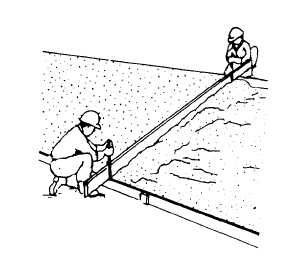consolidate concrete by spading, insert the spade along the inside surface of the forms (figure 7-43), through the layer just placed, and several inches into the layer underneath. Continue spading or puddling until the coarse aggregate disappears into the concrete.
FINISHING CONCRETE
LEARNING OBJECTIVE: Upon completing this section, you should be able to describe the finishing process for the final concrete surface.
The finishing process provides the final concrete surface. There are many ways to finish concrete surfaces, depending on the effect required. Sometimes you only need to correct surface defects, fill bolt holes, or clean the surface. Unformed surfaces may require only screeding to proper contour and elevation, or a broomed, floated, or trowelled finish may be specified.
SCREEDING
The top surface of a floor slab, sidewalk, or pavement is rarely placed at the exact specified elevation. Screeding brings the surface to the required elevation by striking off the excess concrete. Two types of screeds are used in concrete finishing operations: the hand screed and the mechanical screed.
Hand Screed
Hand screeding requires a tool called a screed. This is actually a templet (usually a 2-by-4) having a straight lower edge to produce a flat surface (or a curved lower edge to produce a curved surface). Move the screed back and forth across the concrete using a sawing motion, as shown in figure 7-44. With each sawing motion, move the screed forward an inch or so along the forms. This forces the concrete built up against the screed face into the low spots. If the screed tends to tear the surface, as it may on air-entrained concrete due to its sticky nature, either reduce the rate of forward movement or cover the lower edge of the screed with metal. This stops the tearing action in most cases.
You can hand-screed surfaces up to 30-feet wide, but the efficiency of this method diminishes on

Figure 7-43.-Consotidation by spading and a spading tool.
surfaces more than 10-feet wide. Three workers (excluding a vibrator operator) can screed approximately 200 square feet of concrete per hour. Two of the workers work the screed while the third pulls excess concrete from the front of the screed, You must screed the surface a second time to remove the surge of excess concrete caused by the first screeding.

Figure 7-44.-Screeding operation.
Continue Reading